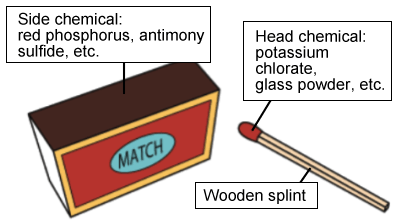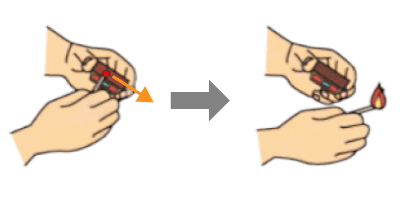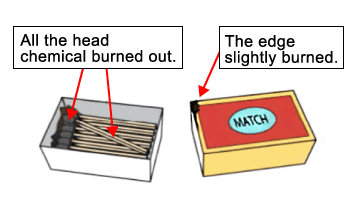Matches in a matchbox caught fire
As soon as a match was struck when a matchbox was slightly opened, the ignited flame spread to the chemical on the end of matches in the matchbox. The product did not indicate a precaution to close the matchbox before striking a match. Therefore, NCAC requested the seller to indicate such a precaution. The following shows details of the consultation case.
Details of the inquiry
I bought a six-pack of matchboxes. My husband took one of the matchboxes and used a match to light a mosquito coil and said "Be careful. The match flares up strongly". I took the second matchbox to light a candle on a Buddhist altar. I struck a match from my side to the opposite side in a standing position when the side chemical on the matchbox faced me and the head chemical on matches inside the matchbox faced the other side. One second later, about 30 matches in the matchbox began to burn furiously. Maybe the matchbox was opened about 1 mm. I dropped the matchbox, but a tatami floor did not burn. My cotton sweatshirt was burned in a small rectangle (2 cm x 1 cm), which made a hole of diameter 4 mm. My undershirt was burned in a circle of diameter 2 mm. I got burned on my breast cleavage, which healed in a day after applying ointment. I felt sick for one day due to inhaling sulfurous smelling gas. If I had worn chemical fiber clothes, I would have got badly burned and a fire would have broken out. I would like to request you to investigate if the product has any safety problem.
Product test and investigation
After receiving the inquiry, the consumer center (hereinafter called "the center") requested the National Consumer Affairs Center of Japan (hereinafter called "NCAC") to conduct a product test, and informed the Consumer Affairs Agency of the matter as an actual and potential consumer-related incident. NCAC conducted the product test and observed the following phenomena.
In the product test, NCAC used the actual product under complaint, a product of the same type (See Diagram 1), and also two different brand products with JIS mark 1 for reference.
- 1 The Japanese Industrial Standard S4001: 2009 (Safety match) specifies that the standard number of matches in a standard size matchbox should be 45 and the minimum number thereof should be 37.
Diagram 1: Illustration of the same type product

A chemical including red phosphorus and antimony sulfide is applied on the side of the matchbox. A chemical including potassium chlorate and glass powder is applied on the head of the match splint.
(1) Match ignition principle
A match can be ignited by rubbing its head chemical against the side chemical on the matchbox. Red phosphorus in the side chemical and potassium chlorate in the head chemical bring about a chemical reaction due to friction and impact when a match is struck, then red phosphorus ignites and the head chemical catches fire, which lights a match (See Diagram 2).
Diagram 2: Match ignition principle

(2) Visual check
Some scratch marks were found on the side chemical of the product under complaint. It appeared that the matchbox had been used only a few times. Thirty six matches were left in the matchbox. The head chemical of all the matches had burned out. Wooden splints mostly remained as they had been. The edge of the matchbox had slightly burned (See Diagram 3). According to these facts, it was considered that the head chemical of matches in the matchbox had burned out one after another but the flame had died down soon, so wooden splints had not caught fire at the time of the incident.
Diagram 3: Illustration of inside and outside of the product under complaint

All the head chemical of matches inside was burned. Wooden splints were not burned. The outside edge of the matchbox was slightly burned.
(3) Ignition check
NCAC observed ignition of matches of the same type product and of the two reference products (Three boxes of each brand product were tested). Each match generated a large flame soon after ignition and then burned stably. Each match sparked a little when it was struck, but did not scatter burning cinders.
When a match flame was attached to the side chemical for three seconds, the matchbox did not catch fire (both the same type product and the reference products).
(4) Simulation test
Matches in the matchbox don't touch the side chemical, so it is hardly considered that a struck match can directly cause ignition of matches inside. It appears that the head chemical of matches inside caught fire from outside. NCAC checked if striking a match would cause phenomena like the above incident when the matchbox was slightly opened and when the matchbox was closed.
When the matchbox was slightly opened
A match was struck to ignite when the matchbox was slightly opened and the head chemical of matches in the matchbox was partly shown to check if matches in the matchbox catch fire (both the same type product and the reference products).
In the test, we saw that soon after a match flare touched the head chemical of matches inside the matchbox, the head chemical caught fire and flamed up. We checked for damage of each product after the test and found that both the same type product and the reference products generated similar phenomena.
When the matchbox was closed
A match was struck to ignite when the matchbox was closed, and a match flare was attached to the edge of the matchbox (near the head chemical of matches inside the matchbox) for three seconds to check if matches in the matchbox could catch fire (both the same type product and the reference products). None of the matches inside the matchbox caught fire.
(5) Labeling check
NCAC checked for indication on the product under complaint, on the same type product, and on the reference products. The reference products indicated "Close the matchbox before striking a match", while the product under complaint and the same type product did not indicate such a precaution.
Summarized outcome
The center communicated the test results to the inquirer, and the inquirer accepted the response. The center also communicated the test results to the seller, and requested the seller to indicate a precaution to close the matchbox before striking a match. The seller responded that they would consider about it. The center communicated the test results to the Consumer Affairs Agency as well.
